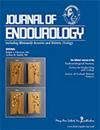求助PDF
{"title":"Evaluation of Optical Tracking to Distinguish Surgeon Experience During Endoscopic Stone Surgery.","authors":"Amy M Reed, Yizhou Li, Jumanh Atoum, Ayberk Acar, Callahan Henry, Jie Ying Wu, Nicholas Kavoussi","doi":"10.1089/end.2024.0246","DOIUrl":null,"url":null,"abstract":"<p><p><b><i>Introduction and Objectives:</i></b> Optical tracking (OT) has shown potential in assessing surgical skill but has yet to be evaluated for endoscopic urologic surgery. We sought to evaluate the potential for OT to distinguish expert and trainee surgeons during flexible ureteroscopy (fURS) for kidney stone treatment in both simulated and live surgical settings. <b><i>Methods:</i></b> We performed OT analysis of six surgeons performing stone localization during fURS in two settings. In the first setting, surgeons were tasked with fiducial localization in three separate kidney phantoms during fURS. In the second setting, surgeons performed stone localization via fURS in five separate patients. Surgeons were categorized as \"expert\" (<i>n</i> = 3, endourologist, average case volume of >100 fURS per year) or trainee (<i>n</i> = 3, trainee, <100 fURS per year). OT metrics were recorded for both settings using the Microsoft HoloLens 2© as the surgeons viewed the surgical monitor during fURS. Standard OT metrics of experts and trainees were compared, and included: area of eye gaze movement, gaze distance traveled, number of gaze fixation points, percentage of gaze fixation dwell time, and number of saccades. <b><i>Results:</i></b> In the simulated setting, the average time for stone localization was greater for trainees compared to experts (318 seconds <i>vs</i> 52 seconds, <i>p</i> < 0.01). Additionally, the mean area of eye gaze movements with area of interest (AOI) was greater for trainees compared to experts (1430 cm<sup>2</sup> <i>vs</i> 1060 cm<sup>2</sup>, <i>p</i> < 0.01). The total gaze distance traveled was also greater for trainees compared to experts (1480 cm <i>vs</i> 730 cm, <i>p</i> < 0.01). In the live surgical setting, average time for stone localization was similar for trainees and experts (74 seconds <i>vs</i> 51 seconds, <i>p</i> = 0.05). The total area of eye gaze movements in AOI was greater for trainees compared to experts (700 cm<sup>2</sup> <i>vs</i> 30 cm<sup>2</sup>, <i>p</i> < 0.01). Additionally, the total gaze distance traveled was greater for trainees compared to experts (14,000 cm <i>vs</i> 680 cm, <i>p</i> < 0.01). This suggests more varied and less point specific concentration on the surgical screen by trainees. There was no difference in percentage of gaze fixation dwell time and number of saccades between experts and trainees in either setting. <b><i>Conclusions:</i></b> OT analysis can objectively distinguish surgical experience between experts and trainee surgeons performing fURS in both simulated and live surgical settings. These findings may play a role in future surgical training and skills assessment.</p>","PeriodicalId":15723,"journal":{"name":"Journal of endourology","volume":" ","pages":"1421-1426"},"PeriodicalIF":2.9000,"publicationDate":"2024-12-01","publicationTypes":"Journal Article","fieldsOfStudy":null,"isOpenAccess":false,"openAccessPdf":"","citationCount":"0","resultStr":null,"platform":"Semanticscholar","paperid":null,"PeriodicalName":"Journal of endourology","FirstCategoryId":"3","ListUrlMain":"https://doi.org/10.1089/end.2024.0246","RegionNum":2,"RegionCategory":"医学","ArticlePicture":[],"TitleCN":null,"AbstractTextCN":null,"PMCID":null,"EPubDate":"2024/10/10 0:00:00","PubModel":"Epub","JCR":"Q1","JCRName":"UROLOGY & NEPHROLOGY","Score":null,"Total":0}
引用次数: 0
引用
批量引用
Abstract
Introduction and Objectives: Methods: n = 3, endourologist, average case volume of >100 fURS per year) or trainee (n = 3, trainee, <100 fURS per year). OT metrics were recorded for both settings using the Microsoft HoloLens 2© as the surgeons viewed the surgical monitor during fURS. Standard OT metrics of experts and trainees were compared, and included: area of eye gaze movement, gaze distance traveled, number of gaze fixation points, percentage of gaze fixation dwell time, and number of saccades. Results: vs 52 seconds, p < 0.01). Additionally, the mean area of eye gaze movements with area of interest (AOI) was greater for trainees compared to experts (1430 cm2 vs 1060 cm2 , p < 0.01). The total gaze distance traveled was also greater for trainees compared to experts (1480 cm vs 730 cm, p < 0.01). In the live surgical setting, average time for stone localization was similar for trainees and experts (74 seconds vs 51 seconds, p = 0.05). The total area of eye gaze movements in AOI was greater for trainees compared to experts (700 cm2 vs 30 cm2 , p < 0.01). Additionally, the total gaze distance traveled was greater for trainees compared to experts (14,000 cm vs 680 cm, p < 0.01). This suggests more varied and less point specific concentration on the surgical screen by trainees. There was no difference in percentage of gaze fixation dwell time and number of saccades between experts and trainees in either setting. Conclusions:
在内窥镜结石手术中评估光学跟踪以区分外科医生的经验。
简介和目标:光学跟踪(OT)在评估手术技能方面已显示出潜力,但尚未对内窥镜泌尿外科手术进行评估。我们试图评估 OT 在模拟和现场手术环境中,在柔性输尿管镜 (fURS) 治疗肾结石的过程中区分专家和实习外科医生的潜力。方法:我们对六名外科医生在两种情况下进行输尿管软镜结石定位时的 OT 进行了分析。在第一种情况下,外科医生负责在 fURS 过程中在三个独立的肾脏模型中进行靶标定位。在第二种情况下,外科医生分别对五名患者进行了结石定位。外科医生被分为 "专家"(n = 3,内镜学家,平均病例量大于每年 100 例 fURS)和实习医生(n = 3,实习医生,结果):在模拟环境中,与专家相比,学员的结石定位平均时间更长(318 秒 vs 52 秒,P < 0.01)。此外,与专家相比,学员眼球注视运动的平均感兴趣区(AOI)面积更大(1430 平方厘米对 1060 平方厘米,P < 0.01)。学员的总注视距离也大于专家(1480 厘米 vs 730 厘米,P < 0.01)。在现场手术环境中,学员和专家的结石定位平均时间相似(74 秒 vs 51 秒,p = 0.05)。与专家相比,受训者在 AOI 中眼球注视移动的总面积更大(700 平方厘米 vs 30 平方厘米,p < 0.01)。此外,学员的总注视距离也大于专家(14,000 厘米 vs 680 厘米,p < 0.01)。这表明受训者在手术屏幕上的注视点更多,更不集中。在这两种情况下,专家和受训者的凝视固定停留时间百分比和囊回次数均无差异。结论:OT 分析可以客观地区分在模拟和现场手术环境中执行 fURS 的专家和实习外科医生的手术经验。这些发现可能会在未来的外科培训和技能评估中发挥作用。
本文章由计算机程序翻译,如有差异,请以英文原文为准。


